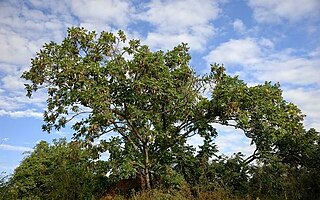
Quassia amara, also known as amargo, bitter-ash, bitter-wood, or hombre grande is a species in the genus Quassia, with some botanists treating it as the sole species in the genus. The genus was named by Carl Linnaeus who named it after the first botanist to describe it: the Surinamese freedman Graman Quassi. Q. amara is used as insecticide, in traditional medicine and as additive in the food industry.

Rhaphiolepis umbellata is a species of flowering plant in the family Rosaceae, native to Korea, Japan and Taiwan. Growing to 1.5 m (5 ft) tall and wide, it is an evergreen shrub with glossy oval leaves, and scented white flowers, sometimes tinged with pink, in early summer.

Alstonia scholaris, commonly called blackboard tree, scholar tree, milkwood or devil's tree in English, is an evergreen tropical tree in the Dogbane Family (Apocynaceae). It is native to southern China, tropical Asia and Australasia, where it is a common ornamental plant. It is a toxic plant, but is used traditionally for myriad diseases and complaints.

Ergosterol peroxide (5α,8α-epidioxy-22E-ergosta-6,22-dien-3β-ol) is a steroid derivative. It has been isolated from a variety of fungi, yeast, lichens and sponges, and has been reported to exhibit immunosuppressive, anti-inflammatory, antiviral, trypanocidal and antitumor activities in vitro.

Nimbin is a triterpenoid isolated from Neem. Nimbin is thought to be responsible for much of the biological activities of neem oil, and is reported to have anti-inflammatory, antipyretic, fungicidal, antihistamine and antiseptic properties.

Newtonia hildebrandtii, the Lebombo wattle, is a medium-sized tree native to eastern Africa. It is a protected tree in South Africa.

Pteleopsis myrtifolia is one of some 10 African species in this genus in the family of Combretaceae. It is the only Pteleopsis species to occur in Southern Africa. Its flowers are strongly scented and perceived by humans to be either 'honey-like' or 'cloying' or even 'stinky'. The timber is red, hard and durable, and used for furniture and construction.

Myrianthus is a genus of flowering plants in the nettle family (Urticaceae). They are mainly found in Tropical Africa. They are mostly tropical trees, shrubs, or lianas. Leaves are simple and pinnately veined or with a palmate structure. It is dioecious, with separate male and female plants.

Ploiarium is a genus of three species of woody plants in the family Bonnetiaceae. It is native to tropical forests and peat swamp forests in Southeast Asia including southern Indochina, Malay Peninsula, Sumatra, and Borneo. Species are generally slow growing with irregular flowering and fruiting cycles. Colonization of plants by arbuscular mycorrhizal fungi is known to improve growth and biomass.

Alstonia congensis, is a tree within the Apocynaceae family and one of two African species within the Alstonia genus, the other being the Alstonia boonei De Wild. Both have similar morphological characteristics.

Aganope stuhlmannii is a deciduous tree within the family Fabaceae. It is native to tropical Africa and grows in savanna woodlands.
Duguetia staudtii is a medium-sized evergreen tree within the Annonaceae family. Species is one of four within the genus Duguetia that is native to Africa.
Boscia salicifolia is a deciduous tree with narrowly ovate to linear leaves that grows up to 12 meters in height, it is within the Capparaceae family.

Lannea schweinfurthii is a small to medium sized deciduous tree within the Anacardiaceae family. The tree is sometimes called 'bastard marula' or 'false marula' because when it is without flowers or fruits, it become quite similar to the marula tree and sometimes it's confused for the marula tree. Extracts of the species is used in traditional human and veterinary medical practices.
Anthonotha macrophylla is a shrub to small understory tree within the Fabaceae family. It is endemic to the rain forest regions of West Africa and it is the most common of species within the Anthonotha genus in Africa.

Berlinia grandiflora is a small to medium sized tree found in the West and West Central African region along riparian habitats or gallery forests habitat types.
Entandrophragma angolense, called the tiama, is a tree species with alternate, pinnately compound leaves that are clustered at the ends of branches. It is within the family Meliaceae and has a wide distribution area, occurring in moist semi-deciduous and evergreen forest regions of Tropical Africa from Sierra Leone to Uganda.
Senecio ruwenzoriensis is an African species of plant. While it is widely distributed, it seems to be highly localised in this range.
Myrianthus holstii is a plant species within the family Urticaceae. It grows either as a shrub or tree. It is considered a dioecious species but a monoecious tree has been observed.
Myrianthus serratus is a dioecious shrub or tree species in the family Urticaceae.













